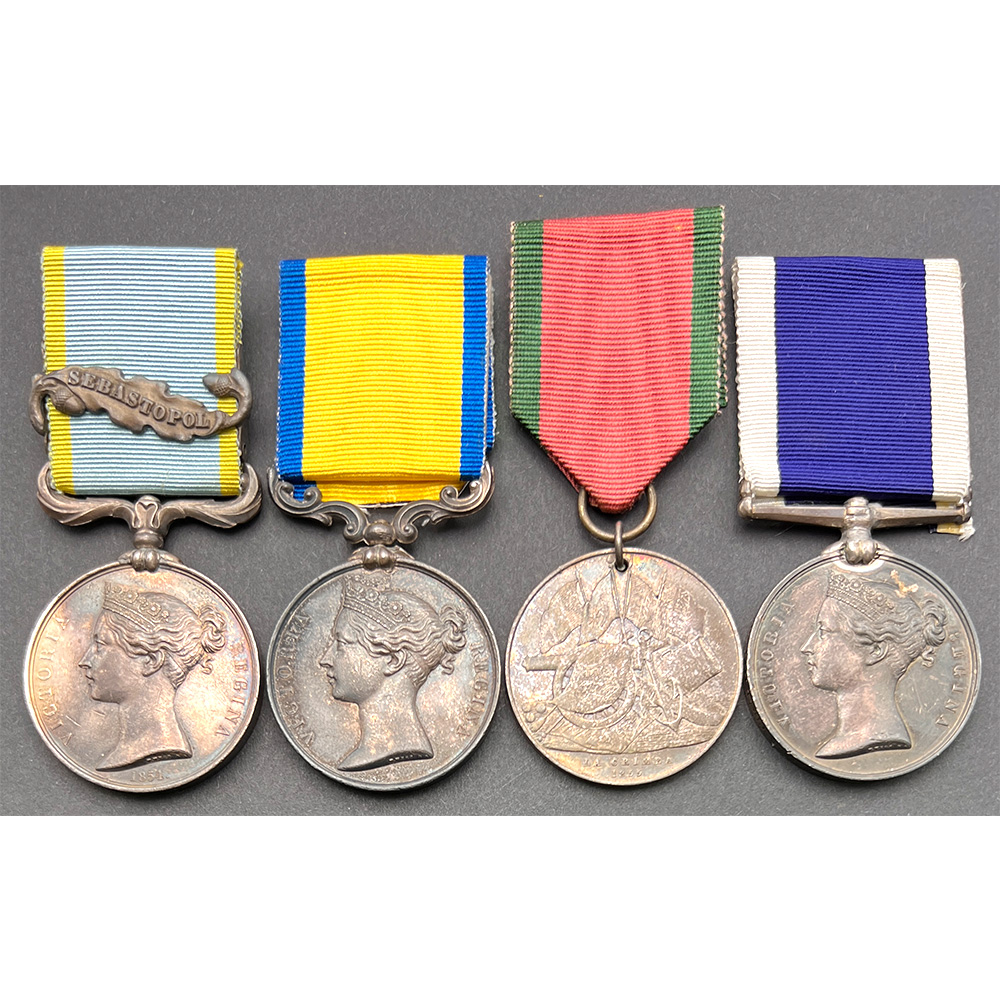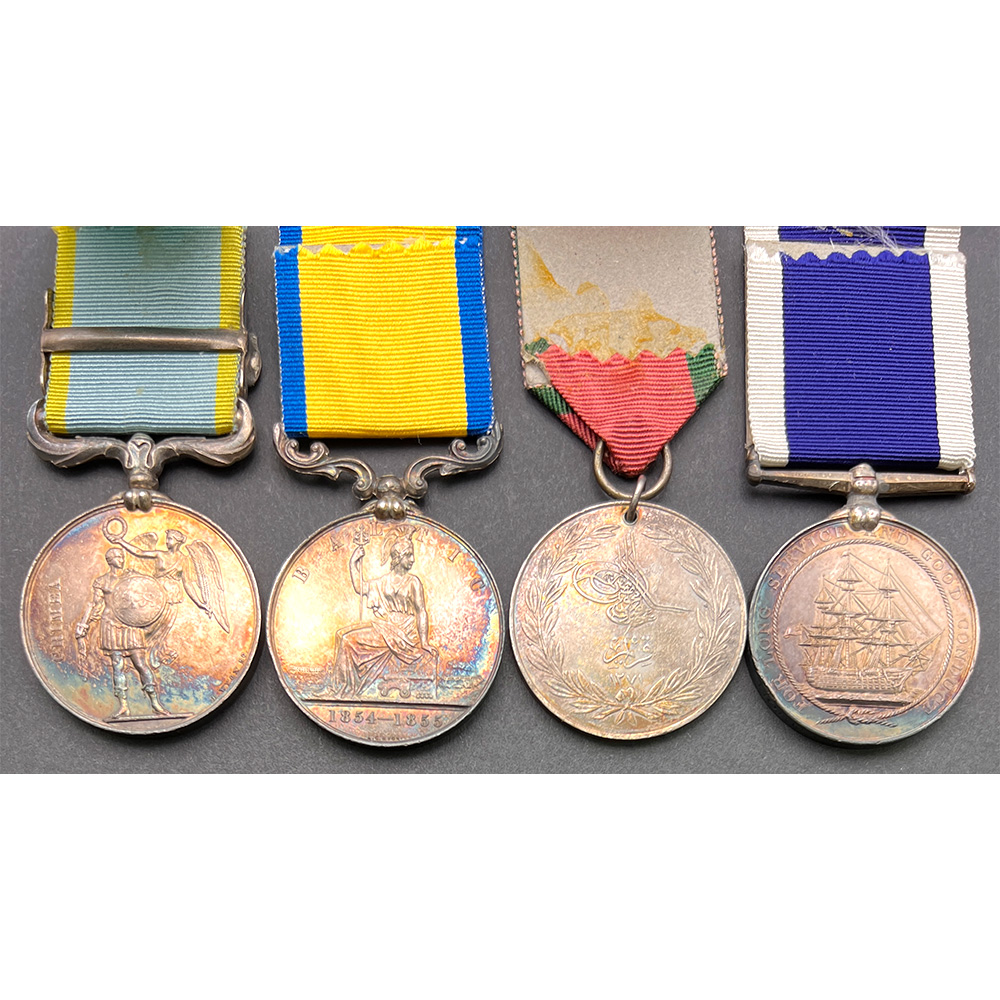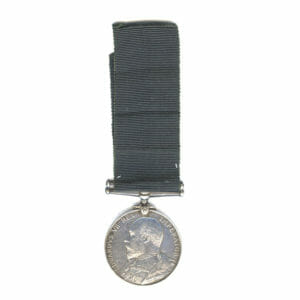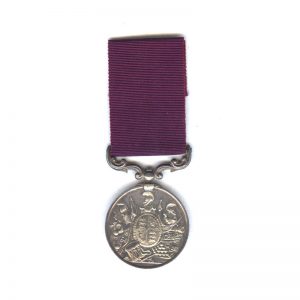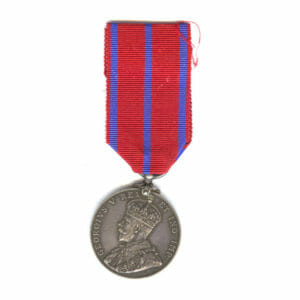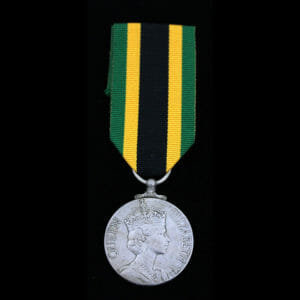Description
Crimea Medal, bar Sebastopol, Baltic Medal, Turkish Crimea, Royal Navy LSGC, VR, Chief Boatman in Charge George Morgan, HMS Odin in Crimea, over 33 years in the Royal Navy and Coast Guard.
Royal Navy LSGC Officially engraved: “GEORGE. MORGAN. CHf BTMn IN CHGe H.M. COAST Gd.”
The other 3 medals are unnamed as issued, nice matching toned condition to all the medals, the Sebastopol clasp loose on ribbon.
Confirmed on the roll for the Crimea Medal on HMS Odin, holding the rank of Captain of the Mn Top, receiving also the Clasp for Sebastopol.
Confirmed on the medal roll for the Baltic Medal, as HMS Odin’s Captain M Top, notes that it was sent to him with the Coast Guard in 2nd May 1857 in Bridlington.
George Morgan spent over 37 years in both the Royal Navy and Coastguard, during this time with the navy he would see action during the Crimean War and in the Baltic Sea with HMS Odin, where he rose from Able Seaman to Leading Seaman also holding the posts of Captain of the Mast and also Captain of the Mizen Top, being later Captain of the Pinnace to HMS Dauntless.
After the war was over, he chose to join the Coast Guard, and went from a Boatman, to Commissioned Boatman, to Chief Boatman settling as a Chief Boatman in Charge.
Chief Boatman in Charge George Morgan, was born in Bath, Somerset on 17th September 1829.
He first volunteered for his terms of service with the Royal Navy on 1st July 1853, having been serving already in the RN since 1849.
In short he saw the following service and postings, he have copies of both his service records spanning from 1849-1873 and the second set from 1873-1886, when discharged to pension:
HMS Scourge, 17th May 1849 – 27th Novr 1852
A.B. during this time.
HMS Odin, 18th January 1853 – 7th August 1856
Joined as A.B. promoted to Leading Seaman on 1st July 1853.
Captain of the Mast from 10th June 1854
Captain of the Mizen Top, 22nd June 1855
Returned to Leading Seaman 26th March 1856
HMS Dauntless, 8th August 1856 – 13th March 1857
During this time Coxswain of the Pinnace from 25th September 1856.
HMS Victory 14th March 1857 – 28th March 1857
Also Coxswain of the Pinnace.
HMS Cornwallis, Coast Guard Station, 1st July 1857.
HMS Audacious (Sherringham), Chief boatman, 1st Jan 1873
During his Coast Guard time he was:
Boatman from 29th March 1857
Commissioned Boatman from 1st Jany 1858
Chief Boatman, 1st Dec 1870
Chief Boatman in Charge, 22nd May 1874.
A letter in his records dated 20th February 1866:
“George Morgan joined the Sandlemere Coast Guard Station from HMS Dauntless, on the 27th March 1857 and served as a Boatman until the 31st December 1857.”
His first service was on board HMS Scourge, during her first commissioned from 17th May 1849 until 27th November 1852, under command of Lord Frederick Herbert Kerr R.N., later Admiral.
During this time she served in the Mediterranean, and whilst onboard they discovered the previously lost Volcanic Island of Isolo Giulina.
“REDISCOVERY OF A VOLCANIC ISLAND:
– It will be remembered that an Island about 120 feet high, and 2000 feet in circumference, suddenly sprang up in 1831, between Sicily and La Pantellaria. it disappeared about a month later, and at a later period, evening the sounding lead could give no indication of its existence: but vessels passing over the place it had formerly occupied, would sometimes feel a shock which showed that it was of volcanic origin. In March last, however, the French Vessel Eole, which was taking soundings in the vicinity, discovered some traces of its existence; and we now learn from Naples, that in the course of last month, HMS Scourge, Captain Kerr, verified the truth of the preceding observation, and further discovered that the island, which has been christened “Isolo Giulia,” was only 9 feet under water. Captain Kerr had a pole with a Streamer and an inscription set up on the spot – Journal des Debats.”
A letter in the London Evening Standard, 10th April 1852 recalls the end of her service:
“THE MEDITERRANEAN, MALTA APRIL 2
The only Naval movement since our last is the departure of the Scourge, 6, Steam Sloop, Commander Lord F. Kerr, on Saturday last, for Corfu, whence she would, it is said, proceed to Constantinople, to be placed at the disposal of Sir S. Canning.
It is gratifying to be enabled to relate an anecdote illustrating the kindly feeling which Admiral Dundas is disposed to entertain towards the commercial interests.
A Captain Inglessi, in command of an Ionian Brig, the Angelica, which was recently struck by lightning, and foundered in the roadstead of Argostoli, arrived here, and on making Admiral Dundas acquainted with the fact, asked him to lend the diving apparatus at his command, with a view to examine the brig before endeavouring to raise her.
The admiral not only complied with the wish of the applicant, but put on board The Scourge the diving apparatus, men to use it, the applicant, Captain Inglessi, for a passage to Cephalonia, and gave instructions to Lord F. Kerr to render every assistance in his power to raise the brig.
We need hardly say that a letter of thanks, by the agent of the owner, in his own name and in that of the owner, has been sent to the Admiral, and made public in one of the local papers, and the courteous acts of the Admiral is greatly admired.”
